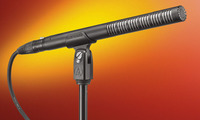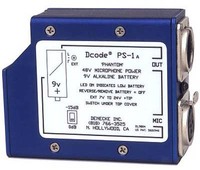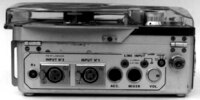 Condenser mics require external powering such as 12volt T or 48volt Phantom, which can be supplied by an accessory battery power supply plugged in line between the microphone and the mixer/recorder. Most mixers, recorders, and camcorders offer built-in mic powering.
Condenser mics require external powering such as 12volt T or 48volt Phantom, which can be supplied by an accessory battery power supply plugged in line between the microphone and the mixer/recorder. Most mixers, recorders, and camcorders offer built-in mic powering.
Examples of condenser shotguns include the Audio Technica BP4073 (shown here) and BP4071; and the Sennheiser MKH416, MKH60, and MKH70.
A note here on microphone powering, which is an area very confusing to many people. As stated before, dynamic mics do not require any external powering, and plug directly into the MIC INPUT of a mixer/recorder. Electret condenser mics are self-powered (by an internal battery) and also plug directly into the MIC INPUT. Condenser mics require external powering, which can be a battery supply (such as the Denecke PS1A, shown below) located anywhere along the mic cable path.
 For instance, the mic connects to a regular XLR cable, that cable plugs into the power supply, and then another short cable connects the power supply to the MIC INPUT.
For instance, the mic connects to a regular XLR cable, that cable plugs into the power supply, and then another short cable connects the power supply to the MIC INPUT.
In all of the above cases, if the mixer/recorder offers the option of mic powering, that option IS NOT USED. The correct MIC INPUT setting would read "dynamic."
Sometimes, we can power a CONDENSER mic directly from the mixer or recorder. In that case, the external battery supply is not used at all, and the mic plugs directly in. A switch near the MIC INPUT should be switched to "48 Phantom" or "T" or "A-B", depending.
Condenser mics come in two basic varieties: 12 volt T or 48 volt Phantom. The designations "12 volt T" and "12 volt A-B" mean the exact same thing, by the way. The difference between T powering and Phantom is significant.
T powering involves sending 12 volts up the mic line along pins 2 and 3 of the mic cable. Traditionally, pin 2 is PLUS and pin 3 is MINUS. Pin 1 is simply used for shield and ground.
 Phantom Power uses all three pins to send 9 to 48 volts of powering up to the mic. Both pins 2 and 3 are PLUS, and pin 1 is MINUS. Some mics are advertised as being able to function at 9 or 12 volts Phantom. However, all of the premium condenser mics that I have encountered prefer and are rated for 48 volt Phantom.
Phantom Power uses all three pins to send 9 to 48 volts of powering up to the mic. Both pins 2 and 3 are PLUS, and pin 1 is MINUS. Some mics are advertised as being able to function at 9 or 12 volts Phantom. However, all of the premium condenser mics that I have encountered prefer and are rated for 48 volt Phantom.
In theory, Phantom power should not interfere with the operation of dynamic mics, since the voltage is balanced equally across pins 2 and 3 (which conduct the audio signal). Experience dictates otherwise. Although most dynamic handhelds are not affected, the same is not true of all electronic based mics, such as some wireless.
 There is one more complication to be aware of, namely the term "red dot". In the early days of filmmaking ("b.bc." or before Beta Cam), people only used Nagra recorders for audio. Because Nagras are positive ground, they were set up with T-powering that was pin 3 PLUS and pin 2 MINUS. To correct for this, most mics intended for film use were modified to match this reversed standard, and were designated as "red dot" mics because a red dot was usually (but not always) engraved on the side.
There is one more complication to be aware of, namely the term "red dot". In the early days of filmmaking ("b.bc." or before Beta Cam), people only used Nagra recorders for audio. Because Nagras are positive ground, they were set up with T-powering that was pin 3 PLUS and pin 2 MINUS. To correct for this, most mics intended for film use were modified to match this reversed standard, and were designated as "red dot" mics because a red dot was usually (but not always) engraved on the side.
Today, one will encounter quite a number of Sennheiser 415/416/815/816 shotgun mics that are "red dot" polarity. To make them work with non red-dot power supplies, simply use a reversing cable between the mic and the power supply. A reversing cable is merely a short mic cable that has the leads switched in one connector, so that pin 2 goes to 3, 3 goes to 2, and 1 remains connected to 1.
Now, onto the other way we classify mics: by pickup pattern.
